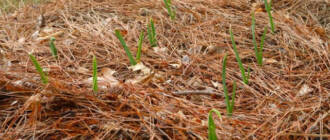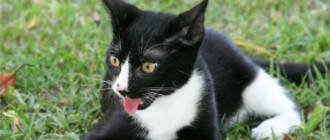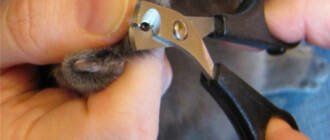The country has more than 60 ethnic groups. The capital is Yamoussoukro (242,000 inhabitants), the main city is Abidjan (economic capital with a population of about 3 million people). The official language is French; the main local languages are Gyula, Baule, Bethe. Independence Day is a national holiday (August, 7th, 1960).
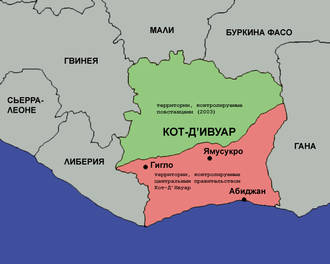
- Cote d'Ivoire: Africa has its own New York City
- The country of Côte d'Ivoire. Where is it located? What does this interesting name mean?
- When to go
- Beaches
- Ivory Coast is a country with a lot of history. Cote D'Ivoire.
- Economy
- Foreign capital
- Côte d'Ivoire. In search of beauty
- But a little about elephants.
- What about the name?
Cote d'Ivoire: Africa has its own New York City
Cote d'Ivoire is one of the best countries in Africa. Well, for one thing, it has a great name. They say some people even call their cats that. Secondly, it is relatively safe by African standards. No one will take away your camera on the street, no need to leave expensive jewelry and watches in the hotel. The people here in general are very friendly. Thirdly, it is relatively clean, again, by African standards.
The name of the country comes from the French Cote d'Ivoire, which translates as Ivory Coast. The country is called in French because it was a French colony until 1960, and the language of the colonizers is still the official language here. Which is understandable: 60 different tribes live in Côte d'Ivoire, and they would not understand each other in their own languages. The name "Ivory Coast" appears for a reason: Europeans who first sailed into the country in the 15th century started exporting it. They exported gold and slaves at the same time.
When the French left in 1960, the so-called Ivorian miracle began. The newly independent country began to develop socially and economically, and also to increase in population. Refugees contributed to this: people moved to Côte d'Ivoire from poor neighboring countries, like Burkina Faso. As a result, Côte d'Ivoire's population grew from 3.7 million to more than 12 million in its first 28 years of independence. And Abidjan, the largest Ivorian city, became the third largest French-speaking city in the world, second only to Paris and Kinshasa!
Cote d'Ivoire used to be one of the most successful countries in Africa! After independence in 1960, it developed at the same pace as the countries of Southeast Asia, and its economy grew by 11% per year. But it all came crashing down with the death of the first president. His successor, Henri Konan Bedié, launched a national cleansing, restricting the rights of refugees and their descendants, which led to a civil war that lasted more than three years.
Côte d'Ivoire's economy is now supported by agriculture. The country is the world's largest producer of cocoa, and cocoa and coffee together account for a quarter of all national GDP. In absolute numbers, it's not so bad: The Ivorian economy is the 12th largest in Africa by size, but Côte d'Ivoire is not even in the top 20 in GDP per capita on the poorest continent. According to 2018 data, about 40% of the country's population lives below the poverty line.
The country of Côte d'Ivoire. Where is it located? What does this interesting name mean?
The modern name of the country originated this way. The country used to be called the Ivory Coast. The name was once translated verbatim into French: Côte-d'Ivoire. Côte is French for coast, ivoire for ivory. In English, ivory is also spelled similarly: ivory, and the country is called Ivory Coast. The word came into European languages (a rare case) from African languages, where it meant both elephant and ivory. Perhaps it is an Egyptian word ab, from which came the Latin ebur – ivory, as well as products made of it. From Latin the expression came (with modifications) into modern European languages. This includes the famous expression "living in an ivory tower".
A country with a very unusual name, it turns out quite a large number of citizens is known for one fruit, because now Cote d'Ivoire is one of the main exporters of pineapples to Russia.
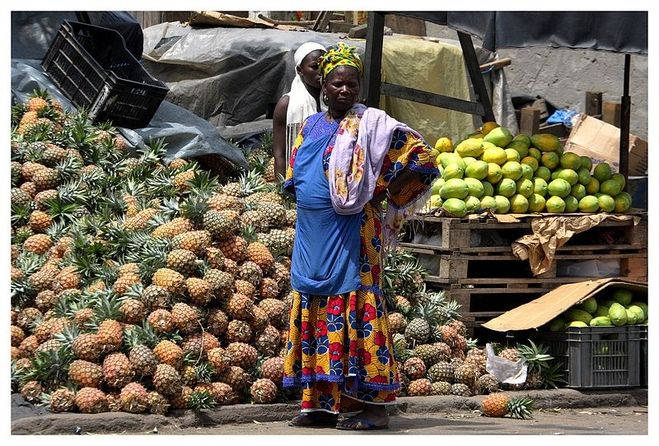
The capital of this country is a city with a very beautiful architecture and with an equally unusual name Yamoussoukro .
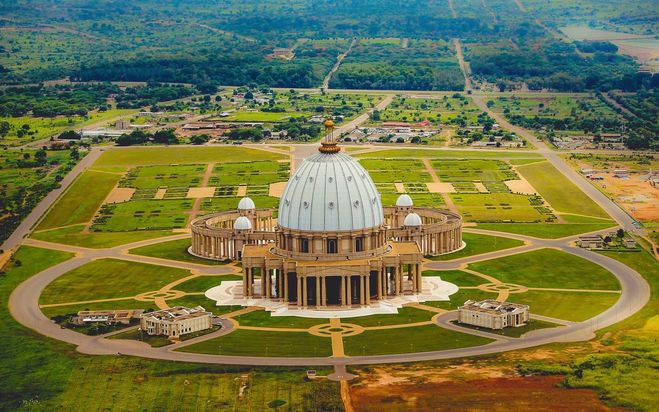
Cote d'Ivoire (before 1986 the country was commonly known as the Ivory Coast) is a state located in West Africa on the shores of the Gulf of Guinea. Its area is 322 460 km². As of last year, its population was 23,740,424. Until 1960 Cote d'Ivoire was one of France's colonies, and later became an independent presidential republic, but still retaining French as the official language.
Most of the population of this country is engaged in agriculture (in addition to pineapples it is also crops of cocoa, coffee) and carefully preserves the traditions and beliefs that were founded earlier.
When to go
The rainy season is from May to July and from October to November. The downpours and thunderstorms are heavy and long, sometimes up to several days. Roads at this time become impassable. In January-February, a sandy wind blows from the Sahara, the harmattan,
The best time to visit Côte d'Ivoire is from December to February. The temperature during the dry season is kept no higher than +35 ° C. We recommend bringing UV-protective sunglasses, a panama, repellent, cotton clothing with long sleeves.
Beaches
Unlike most African countries, the beaches in Côte d'Ivoire – with a high level of service. Vacationers can fully enjoy a relaxing vacation or go surfing.
Sassandra. Well-equipped tourist area. It is a long strip of sand surrounded by rainforest. The best place for surfing is Beach de Bivac and the adjacent Poli Beach. It has the biggest waves on the coast.
Assini. Well maintained, perfectly clean, with white sand and a gentle descent into the water. Surfers appreciate it for a good wave, and lovers of sunbathing – for the quiet and not crowded. Locals sell fruit, soft drinks, and souvenirs.
Monogaga. One of the best beaches in Côte d'Ivoire, located between San Pedro and Sassandra. It is popular with locals and tourists. Vacationers are offered many beach activities, including surfing, beach volleyball, and sand drawing contests. You can also try seafood dishes here.
Ivory Coast is a country with a lot of history. Cote D'Ivoire.
Have you ever heard mention of a country called "Ivory Coast"? No? Then sit back and let me give you a brief history.
In the first millennium B.C. the territory of today's Côte d'Ivoire was completely populated by Pygmies. Because the territory was large and the settlement small, the Senufo began to join the already local inhabitants.
Europeans first landed on this land in the 15th century.
It was then visited by representatives of two "not insignificant" … Portugal and Holland. . The first of them had the opportunity to "feel" the beauty of these places in the 1460s.
However, this did not lead to colonization, which was successfully carried out by the French in the middle of the nineteenth century, trying to settle and cultivate the local land to their liking.
The French managed to take "the most" from the land, often harvesting numerous crops, including even an entire banana plantation, not to mention expensive stones.
March 10, 1893. The BSC estate was given to the rule of French West Africa. Thus it became a French colony.
Soon Ivory Coast was called the most successful estate, in part because of the incredible advancement of the French trade market.
On December 25, 1999, there was a military coup d'état. It was organized by a certain Robert Guay, and a year or so later he ran for president of the country.
- By the way, not all settlers of modern Côte d'Ivoire speak the national language. The country includes representatives of different states, of which there are about 50 in these places. Moreover, almost most of the settlement has a peculiar exotic culture.
Economy
Advantages: well-developed agriculture; important producer of cocoa (first in the world) and coffee (third in the world). Relatively good infrastructure. Growing oil and gas industry, significant foreign investment. Beneficial redistribution of debts.
Weaknesses.Instability. Lack of investment in education. Strong dependence on cocoa and coffee (about a quarter of the country's GDP comes from exports of cocoa beans and coffee [4] ), slave labor on plantations.
On average, the country's economy in recent years has shown steady economic growth of 2.5 – 3% per year (minus inflation), and GDP per capita in Cote d'Ivoire in 2009 amounted to 1.7 thousand dollars, which is quite high by the standards of Black Africa (15th place in the region). Below the poverty line is 42% of the population (in 2006).
Agriculture employs about 70% of the active population of the country, the products of this sector provide more than 60% of export revenues to the budget. Côte d'Ivoire is Africa's largest exporter of palm oil and natural rubber. In addition to coffee and cocoa, the main export crops include bananas, cotton, sugar cane, and tobacco. Coconut and peanut cultivation are also well developed.
In forests, valuable woods are being harvested (including ebony) and gevea sap is being collected (for production of rubber). Sheep and goats are bred for agricultural needs; commercial fishing is carried out.
Oil and gas are extracted basically on a continental shelf. There are also deposits of nickel, manganese and iron ore, as well as bauxite, diamonds and gold.
Foreign capital
French capital plays an important role in the economy. Among the largest French corporations in Côte d'Ivoire are Total (oil production and refining), Électricité de France (energy), Michelin (tire production), Lafarge (building materials), "Transdev/Setao and Bouygues (construction), France Telecom (telecommunications), Groupe Castel/Solibra (beer and beverages), BNP Paribas, Crédit Agricole/Credit Lyonnais and Societe Generale (financial services).
Côte d'Ivoire. In search of beauty
I have a sincere desire to overcome with my materials the persistent prejudice that the African continent in general and West Africa in particular is some horrible assortment of starving children, military coups, permanent civil wars, Ebola, malaria, horrible unsanitary conditions and cannibalism.
Children and the rare adults who look at the world only through rose-colored glasses, when they hear the word "Africa." The images that come to mind are herds of elephants wandering against the background of Kilimanjaro, cute hippos crowding a muddy lake with their fat bodies, numerous zebras, antelopes, gazelles peacefully grazing on the endless expanses of the savanna, Victoria Waterfall, the source of the Nile, dancing Papuans…
But most adults, the older, the more distinctly associations arise of an entirely different kind. They are inspired by news feeds, tabloid reports, and preconceived notions of people who have visited the black continent by chance.
These associations reek of a garbage dump, and make you squeamish and want to wash your hands, or better yet, take a quick shower and then wipe your entire body with alcohol.
Their adamant opinion is never, under any circumstances, to go to Africa and not even look in its direction, saying foo-foo. That's a familiar sentiment, isn't it?
I will not claim that dirt, poverty, hunger, devastation and infectious diseases are in great short supply on the African continent. All this is certainly there, but not everywhere and not always.
Do bloody ethnic wars, military coups, epidemics that claim thousands of lives happen? It would be foolish to say no. In some countries often, in others less often, and somewhere almost never. Africa is so different.
I would like to dedicate this last story from Côte d'Ivoire to the search for beauty, and also to understand how the colonial past of a country has influenced its present appearance, for I think that the influence of former metropolises predetermines much of the diversity of African countries, as well as the diversity of individual territories of an African state.
But a little about elephants.
В Côte d'Ivoire at the end of 2020, there were only 225 elephants. By comparison, there were over 1,600 in 1994 and about three thousand in 1980. Over the past two decades, about 90% of Côte d'Ivoire's elephant population has disappeared.
A precipitous decline. Are tusks so expensive that poachers are not afraid of any prohibitions and stack elephants? Not quite so, although that too is significantly present in a poor country.
But the fact is that in this country elephants are not "ordinary" but forest elephants. And that is a separate species, like the savanna elephant. And in half of the country's conservation areas, the forests have been completely cleared for farmland.
And perhaps in the next few years the Elephant Coast will be left without elephants at all. Such is the price of population growth.
What about the name?
Once again, my little discovery of America. discovery of America, or rather Africa.
Yes, the name has changed. And at the same time it hasn't. How so? – A reader who does not speak French will ask me. I answer:
The title in Russian has changed. The words have changed, but not their meaning.
And the notorious cat – is French côte [kot] noun f (see translator)
- coast cf, shore m, shoreline, seashore (littoral, rive, rivage)
- rib cf(bord)
- hill m, slope m, slope m(colline, coteau)
- coastal zone
- overhang m, ridge(promontoire, crête)
- cuesta m
- vein (nervure)
- roll m(bourrelet)
А "д' " -is a very polysemous French preposition "de" . In this case it is abbreviated and denotes belonging and the genitive case.
It is simply that the government decided that the name should not be translated. Until 1986, the name of the state was officially translated into Russian as Republic of the Ivory Coast. . In October 1985, the congress of the ruling Democratic Party decided that "Côte d'Ivoire" was a geographic name and did not need to be translated from French.
And a little life story (spied on the Internet).
In one school, there was an order on the bulletin board reprimanding an elderly professor for constantly mentioning in his geography lectures the country of "Ivory Coast," which supposedly is no longer on the maps. This amused me a great deal, though I am well aware that young people do not go into science and teaching very much.


